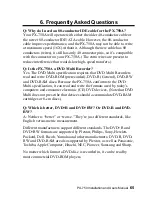
Section 6. Frequently Asked Questions
66
PX-750 Installation and Users Manual
Q: What's the difference between "double layer" and "dual layer"?
A: Nothing, really. It's simply a difference of opinion within the industry
about how to label media and drive capabilities. DVD+R DL (as named
by the DVD+RW Alliance) stands for DVD+R Double Layer. DVD-R
DL (from the DVD Forum) stands for DVD-R Dual Layer. Whether
your DL media is labeled "double layer" or "dual layer," the PX-750 can
handle it.
Q: What is “recommended media”?
A: Recommended media are recordable or rewritable CD and DVD
media that have been tested by Plextor and found to operate well
consistently, from one manufacturing lot to another. For each drive,
Plextor engineers test media from many different manufacturers and
manufacturing facilities, creating a recommended media list and
determining the optimum write strategy for that particular media type.
The results are listed as “recommended media,” and are also assembled
into a media catalog and stored in firmware in Plextor drives. (See the
Plextor web site at www.plextor.com for a list of recommended media
for the PX-750.)
From time to time, the media catalog is updated with new manufacturers
and part numbers as Plextor tests additional media. When this happens,
Plextor makes new drive firmware available. You can download this
new firmware and update your drive.
Q: In the list of Recommended Media, what’s the difference
between “rated,” “compatible,” and “recommended” speeds?
A: “Rated” is the manufacturer’s rated write speed for the media; it’s
what you see on the box. “Compatible” is a looser term that indicates the
maximum safe writing speed according to the manufacturer.
“Recommended” is the Plextor-recommended speed for ensuring top-
quality writing using this media. Plextor tests media and enters the
“compatible” and “recommended” speeds into the drive’s media catalog.
















































